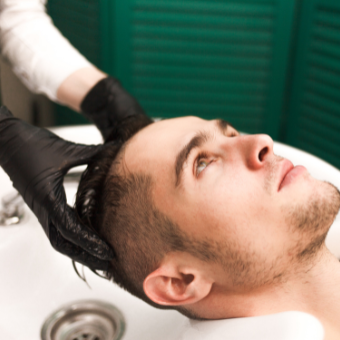In recent years, we’ve seen an overlap between the skin care and hair care industry—a new approach to hair and scalp care consisting of skin care-inspired products and treatments. After all, the scalp is skin!
During the pandemic, scalp and hair issues became more prominent—particularly hair loss—and as a result, the “skin-ification” of hair care is booming. In fact, skin care brands are now branching out into hair care. Before we dive into some of the popular skin care treatments for hair loss and scalp issues, let’s touch on some of the causes of hair loss.
Causes of Hair Loss
Hair challenges, including hair loss and shedding, should be viewed as a combination of factors. It’s also important to remember that a certain amount of hair loss is normal. Here are just a few of the many factors that may lead to hair loss:
- Hair Care: Whether your guests color their hair, chemically straighten it with treatments like Brazilian Blow out, or wear tight updos, this can cause damage to their hair and over time lead to hair loss.
- Alopecia Areata: This is a disease that develops when the body’s immune system attacks the hair follicle, causing hair loss. It affects not just the hair on top of the head, but anywhere a follicle is present—ears, nose, eyebrows, or lashes.
- Telogen Effluvium: This condition is brought on by stress and results in the hair staying in the telogen stage. An Increase in stress releases cortisol and sometimes results in thinner hair, shedding of hair, or in extreme situations, the hair coming out in clumps.
- Genetics, Age, and Illness: According to the Cleveland Clinic, 30 percent of women experience genetic hair loss, known as female pattern hair loss. This is gradual and will get worse with age. As we age, our hormone levels change, and thinning hair or a receding hairline is common.
- Temporary hair loss is normal after a fever or illness and is referred to as telogen effluvium. A fever or illness, like what may occur during COIVD, can force hairs into the shedding face. This is temporary and resolves within months.
- Temporary hair loss is normal after a fever or illness and is referred to as telogen effluvium. A fever or illness, like what may occur during COIVD, can force hairs into the shedding face. This is temporary and resolves within months.
- Scalp Psoriasis: your guests who suffer from plaque psoriasis may also suffer from this condition on their scalp. The overproduction of “plaque” or cell proliferation may lead to irritation, itching, and possibly hair loss in the area.
- Scalp Infection: A scalp infection can present itself as scaling skin, red irritation, itching, and even small black dots on the scalp. These dots are stubs of hair and guests may develop bald spots.
Skin Care Treatments for Hair Loss
- Collagen Induction Therapy/Microneedling: While used as an antiaging skin treatment, microneedling may also be a method of treatment for hair loss. The same process of creating wounds in the skin is also thought to regenerate the health of the hair follicles. This procedure can be combined with the guest’s platelet-rich plasma (PRP), which contains active growth factors and can promote hair growth.
- HydraFacial Scalp Treatment: This treatment cleanses, exfoliates, and hydrates the scalp and hair follicles. It also removes dirt, oil, flakes, dead skin cells, and impurities from the surface of the scalp and from hair follicles. It stimulates scalp circulation and infuses the scalp and hair follicles with growth factors and skin proteins to promote the appearance of healthier, thicker, fuller-looking hair. It is recommended for everyone, regardless of skin and hair types. Whether someone has thin, brittle hair or an oily scalp, the treatment can address any need.
- Scalp Micropigmentation: For those guests who want an immediate result and the look of thicker, fuller hair, scalp micropigmentation is a noninvasive treatment that uses micro-needles to deposit pigment into the scalp. The result creates the appearance of tiny hair follicles that help thicken and restore the look of fuller hair. This treatment is for both men and women. Men can achieve the look of a buzz cut or eliminate a receding hair line. Women can avoid the look of thinning hair by creating the illusion of tiny hair follicles.
- Fractional Laser Therapies: Laser therapy has been reported to increase hair growth and activate hair follicles. Nonablative fractional lasers create microchannels in the skin like microneedling and may be accompanied with a hair growth serum.
It is important to always stay within your scope of practice. Each state has different rules and regulations, and it is not uncommon that estheticians may not be able to touch the hair or the scalp. Further, if you are performing pigment procedures or laser procedures, some states may require a secondary license or a medical director to oversee these procedures.
